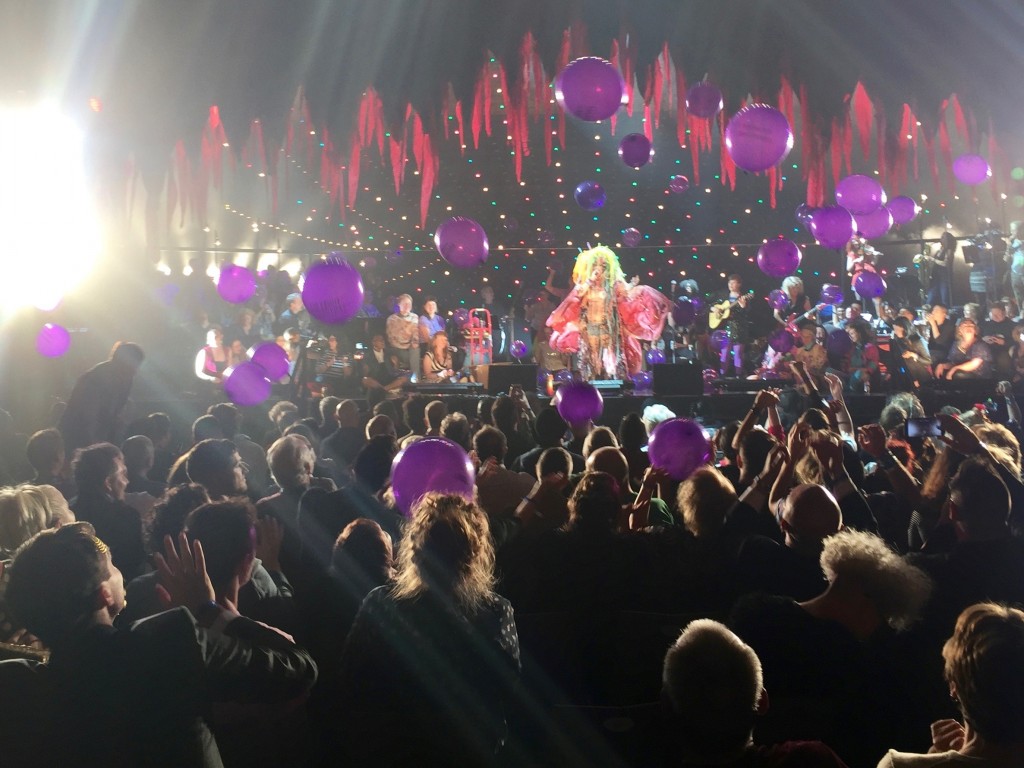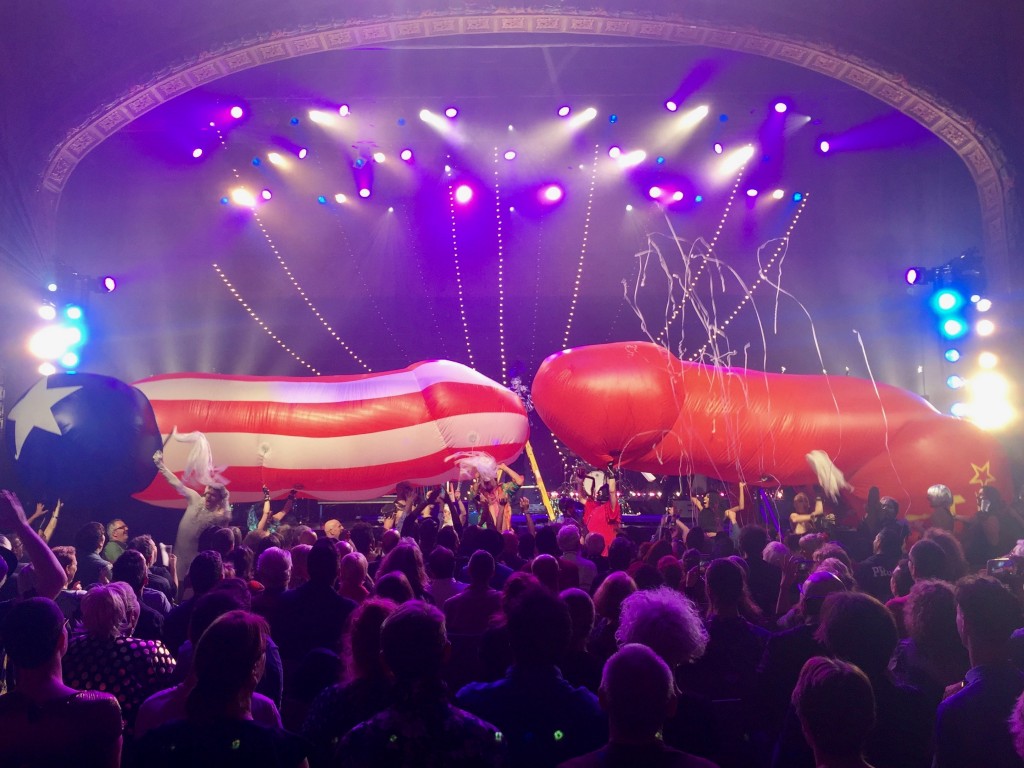By Taylor Mac, at Melbourne Festival
Wed 11 – Fri 20 October 2017 | Forum Melbourne
- These are notes, not a review.
- I’ve never used my blog for this kind of writing before. I’m giving it a try.
- Leave a comment if you like.
- I may write more after each part of the show. I might not. I might type this up into something more formal. Or not.
- Taylor Mac uses “judy”, lowercase, not as a name but as a gender pronoun.
See Notes on Chapter I | See Notes on Chapter II | See Notes on Chapter III
Chapter IV: 1956-Present
It is over. The whole cycle of A 24-Decade History of Popular Music is complete. A work I attended for 24 hours, but which continued for two weeks, stealing the space in between its four chapters, occupying consciousness and dreams alike. I made friends with the strangers sat beside and in front of me. To my right was Elisa who came alone for the whole 24 hours and cried eight times in Chapter IV, or so she said and I believe her. In front of me were Winston and Leigh, a senior couple who invested in the 24 hours because they knew the show might be the antidote to the roughness of the times. I watched them comfort one another, hug, cheer and laugh over the hours. Their intimacy and ease together really inspired me. I was moved that this was a space where they could be themselves. Winston’s head framed the left of my view, and Leigh’s the right. I fed at least one of them a grape. They gave me a peanut.
Again, these notes are less about the detailed content of the show and more my thoughts on the event itself.
A Tree is Best Measured When it is Down
Taylor Mac and Matt Ray’s project has some echoes of Robert Wilson’s vision for the CIVIL warS: a tree is best measured when it is down (sic.) an epic, day-long five act opera conceived to accompany the 1984 Los Angeles Olympic Games, though never fully realized. While there are many differences, most notably Wilson’s vision was for opera, while Mac’s is for pop, the theme of civil war is central to both works. Though in Mac’s show the civil war is perennial, an ongoing battle for civil rights, and not only battlefield warfare of trenches and troops. Mac’s is the war for equality within a society. And that is why the show is 24 decades long: the revolution was not over at the signing of the Treaty of Paris or even the Constitution, and continues to this day. The comparison between these two queer auteurs’ work is worthy of greater attention elsewhere, but suffice to say they both play with time, extending expectations of what can be done with, within, and without it in queer ways. Both collaborate openly, delegating major aspects of their productions, particularly the musical composition to others without tinkering in their creations. However, a key difference is one of calamity, the chaos of performance, which Mac embraces as a central organizing principle, and Wilson attempts to expunge. Taylor Mac wanted to make a show so long it was impossible for it to be perfect, as “perfection is for assholes”, and so was able to complete the 24 hour extravaganza. Wilson on the other hand is famously fastidious and demanding of as close to perfection as possible, providing exacting shapes for the bodies of his performers through detailed rehearsals, and so, maybe, was unable to complete his epic vision with the (vast) resources available to him.
These two epic civil war projects queered the times of their production and got close to the Pulitzer Prize for Drama. Arguably both should have won. The 1986 jury unanimously awarded the CIVIL warS the prize but were over-ruled by the supervisory board, meaning no prize for drama was awarded that year. Thirty years later the 2017 board was faced with a similarly unruly queer vision of what theatre and drama can be. 24 hours long, it comprised a lot of songs, but also at least 10 hours of original writing, performance art and participation that collectively cuts to the core of the American psyche, but also did not win. The trouble with queer work like Mac’s is that it is hard to handle and categorise, falling between many stools. Clearly, it was simply not dramatic enough, and did not look enough like what was already known to win this year’s prize.
Re-membering and un-membering
Memory, specifically how to remember, is central to A 24-Decade History of Popular Music. Taylor Mac and MD and Arranger Matt Ray have an uncanny ability to remember huge chunks of complex material. Taylor never seemed phased ploughing into many similar sounding verses of old songs or breaking into long tracts of poetry. Somehow the words just tumble out of judy’s mouth with meanings as clear as the first time they were thought. Extraordinary when you think of how many rockers use autocue for their own songs. Even more impressive is the memory of what comes next in the song order, as the space between numbers can often be the moment where the brain freezes and memory fails. Almost every band I’ve ever seen had a set list of songs taped up somewhere, but Taylor just trotted them out seemingly without cue.
As though the challenge of the preceding 236 (ish) songs were not enough, in the sixth hour of Chapter IV, and the final hour of the show, Taylor sang judy’s own songs. Sung with gusto with only the ukulele as accompaniment (how Taylor Mac started out) these were particularly complex songs with long lists, streams of consciousness and tricky rhythms that are difficult to perform without fluffing a single line, especially at the end of an epic show. But they were pretty much flawless.

These feats of performance memory alone are noteworthy, but the show’s radical act of re-membering is of the corpse of American history, sewn together using its popular songs as revivified organs, limbs and appendages. The monstrous corpus is recomposed in the image of the company that brings it to life; diverse, woke, anarchic and conservative America’s worst nightmare. Many of the nation’s foundational myths are dismembered, held under the microscope, not fully amputated, but remembered differently. The painstaking, often painful suturing of the long-overlooked gashes in that nation’s body, the resetting of its fractured bones, and the relocation of displaced joints is necessary for healing a corpse that refuses to believe it is ill. And while the corpse of American history undergoes exhumation and re-vivification, so too must the deeply buried beliefs and myths wrapped up in each audience member’s body. Each body’s history must be re-inscribed. The audience must be sacrificed to allow the audience to be reborn: within the first 10 minutes of the show the whole front row (those who paid the most for their tickets) will be rearranged; reenacting white flight to the suburbs, white people will be sent to the edges of the room while people of colour will take their pick of the best seats in the front centre of the auditorium and stay there until the end of the show; after an eon of marginalization, lesbians will take pride of place on stage and receive free beer; straight men in their twenties will practice gay sex; white people will moan and groan for an uncomfortably long period to exorcise their white guilt; it will all go on for longer than you want, and you will be uncomfortable.
It was ambitious re-membering. And its discomfort was cathartic. The final dis-membering, of course, is ultimately euphemistic. After the deflation of two giant cold war phalluses, one for USA, one for USSR, there was a parade of extraordinary pussies in the form of the final two costumes – the finest in the show. Ultimately it is a dismembering that we need most of all, an end to phallocentrism, the monolithic, the singular, the patriarchy… maybe re-membering is surplus to requirement?

That said, there were a few inclusivity oversights, like the lack of accessibility to the stage for wheelchair users that meant one of the dandy minions could not get up there. And some neurodiversity slips that I was sensitive too, particularly Crazy Jane. But in the Q&A on Saturday it was clear the company is working through such problems as they arise in an open and constructive way.
You can lie down or get up and play
The last song of the show was performed to 700 people without microphone or amplification. The last line was reserved for the audience, the real protagonists of the show (Taylor Mac’s assertion), who sang ‘you can lie down or get up and play’ on a loop. A mantra from Taylor maybe, who made judy by getting up and playing. A call to action for the audience to live by. A mantra of the self-made America and American: get on with it though it might not be perfect, it gets better with practice, make something, you can always remake it again later…
… like this blog post – it is not a static document and I may change it again later.
It’s over. The streets of the city now seem drab, filled with repressed pain, rigid normative gender, and the hardness of spaces made expedient for capital and the lost souls it strings along. The morning after the show I found myself stood still in the middle of Coles supermarket tapping a cucumber against the palm of my hand for far too long, lost in a daze beneath the harsh lights amongst the jostling and pushing through fruit and veg – there isn’t much room for this kind of thing in the Elizabeth Street store – trying not to cry. This is more difficult than it sounds after the forced withdrawal from the collective re-writing of history I felt part of for two weeks. The circus is packing up and leaving town. I’ve never felt like this about a show before. Even though it was 24 hours long, I am really sad it’s over.
Please share your thoughts and memories of A 24-Decade History of Popular Music in the comments below.